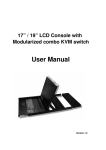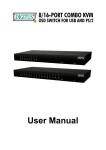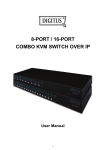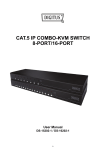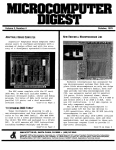Download Longshine LCS-K916 KVM switch
Transcript
Index 1. Introduction 1.1 Features 1.2 Package Contents 3 3 3 2. General Specification 3. SYSTEM REQUIREMENTS 4 4. INSTALLATION 4.1. FRONT VIEW 4.2. REAR VIEW 4.3. SINGLE STAGE INSTALLATION 4.3.1. Precaution: 4.3.2. Console connection: 4.3.3. System connection: 4.4. CASCADE CHAINING 4.5. FIRMWARE DOWNLOAD CONNECTOR 4.6. RACK MOUNTING 4 5 5 5 5 6 6 7 8 8 5. OPERATION 9 4 6. HOT KEY OPERATION 6.1. CALL OSD MENU 6.2. LEADING HOT KEY SELECT 6.3. CHANNEL SELECT - SINGLE KVM 6.3.1. Specific channel selection 6.3.2. Arrow Key Channel Shift Function 6.3.3. <ALT> Channel Shift Function 6.4. CHANNEL SELECT - CASCADE CHAIN LAYER 6.5. BUZZER SOUND DISABLE / ENABLE 6.6. AUTO-SCAN FUNCTION 6.6.1. Start auto-scan function 6.6.2. Stop auto-scan function 6.6.3. Auto-scan mode 6.6.4. Auto-scan time interval 6.7. CONSOLE LOCK 9 9 9 9 9 10 10 10 11 11 11 12 12 12 12 7. OSD OPERATION 7.1. OSD MAIN MENU 7.1.1. KVM layer number 7.1.2. Channel name 7.1.3. Computer & KVM status 7.1.4. Current active channel number 7.1.5. Cascade parent channel number 12 12 13 13 13 13 13 7.1.6. Page down / up indicator 7.1.7. Function Control Menu 7.2. CHANNEL SELECTION IN OSD 7.2.1. Channel select to computer 7.2.2. Channel select to cascade port 7.2.3. Return from cascade port 7.3. SETUP IN OSD: <F1> 7.3.1. Scan Mode 7.3.2. Scan Time 7.3.3. Banner Time 7.3.4. Position 7.3.5. Hot key 7.3.6. Sound 7.3.7. Language 7.4. AUTO-SCAN IN OSD: <F2> 7.4.1. Start to auto-scan in OSD 7.4.2. Stop auto-scan 7.4.3. Auto-scan mode 7.4.4. Auto-scan time interval 7.5. CONSOLE LOCK IN OSD: <F3> 7.6. CHANNEL RENAME: <F4> 7.7. SECURITY SETUP: <F5> 7.7.1. Security mode login 7.7.2. Security Mode 7.7.3. Change administrator password 7.7.4. Authorized user setup 7.7.5. User Authority setup 7.8. LOCK PORT: <F6> 7.8.1. Lock Port 7.8.2. Channel selection of the locked port 7.8.3. Unlock Port 7.9. EXIT OSD: <ESC> 13 14 14 14 14 14 14 15 15 15 15 15 15 16 16 16 16 16 16 16 17 17 17 18 18 18 18 19 19 19 19 19 8. SUN MICROSYSTEMS FUNCTION KEY EMULATION: 19 9.TROUBLESHOOTING : 20 Disclaimer 20 FCC Statement 20 1. Introduction Thank you for purchasing 8-port & 16-port Combo Free KVM Switch! You now have a high quality, durable system to control 8 or 16 computers through PS/2 and/or USB connection from one console (PS/2 & USB Mouse, PS/2 & USB Keyboard, and Monitor). 1.1 Features • • • • • • • • • • • • • • • • Console your Keyboard/Mouse via PS/2 and/or USB at will. Connect computers via PS/2 and/or USB at will. Supports Windows, Linux, Mac OS9/OSX, Sun Microsystems. On-Screen-Display (OSD) & Cascade Chain functions. OSD is intuitive menus driven for quick and efficient navigation. Supports Daisy chain with 3 level cascades: up to 3 levels; control up to 64/256/4096 PCs, from a single console; cascaded units don’t need special configuration. Emulates PS/2 or USB keyboard on each PC to allow your computers to boot normally without a keyboard error. Supports hot-pluggable. All devices connected to the KVM can be added or removed at any time, without shutting the unit down. Supports 3 types of switching: .Hardware Push Button, .Hot-Keys on PS/2 and/or USB of keyboard, .Menu driven OSD (On Screen Display). Supports Auto-Scan function to switch video inputs automatically among computers in preset intervals sequentially by OSD menu driven. Supports LED display for PC and/or server status monitoring. Supports VGA resolutions up to 2048 x 1536 Supports Beeper during Switching enabled. Fully compliant with the USB 1.1/ 2.0 specification. Rack Mountable in 19” system tack (1U). KVM firmware is upgradeable via on-board mini-USB download connector and external miniprogrammer. 1.2 Package Contents The product you purchased should contain the following equipment and accessories: 1 x 8-Port or 16-Port Combo Free KVM Switch . 1 x User’s Manual. 1 x Power adaptor 1 x Rack Mount Kit 2 x Custom combo 4-in-1 cable 2. General Specifications Number Of Computers Controlled 8 or 16 Push Button and Hot-Key (PS/2 / USB Keyboard) Selection Method Or On-Screen-Display (OSD) Red for PC Selection LEDs Green for PC On-Line ready PC Connectors ....................................................................................................................................................... Video 8 / 16 x HDB-15 female (KB/MS) ( PS/2 & USB signal combined ) Console Ports ......................................................................................................................................................... Keyboard 1 x 6 pin mini-DIN female Mouse 1 x 6 pin mini-DIN female Video 1 x HDB-15 female Keyboard 1 x USB – A type female Mouse 1 x USB – A type female Auto-Scan Interval Adjustable time setting by OSD menu driven DDC, DDC2 monitor Yes (Max. Resolution up to 2048 x1536) Hot Swappable Yes Windows 98SE/ME/2000/XP/2003/Vista Server, Operating systems supported Linux, Mac OS9/OSX and Sun Power By external power adaptor Dimensions (L X W X H) 44 x 15.7 x 4.5 cm (17.3 x 6.1 x 1.5 inch ) Unit Weight 1750g / 1900 g Housing material Metal Operating Temperature 32~ 122°F (0~ 50°C ) Humidity 0%~80%RH Firmware upgrade connector Mini USB female 3. System Requirements • Console A VGA, SVGA, Multisync monitor capable of the highest resolution. PS/2 and/or USB Keyboard/Mouse • Computer or Server The following equipment must be equipped with each computer or server. A VGA, SVGA or Multisync card Type A USB port or PS/2 6 pin mini-DIN for Keyboard and Mouse. • Cables The Combo Free KVM Switch must be used specific custom 4-in-1 cables. To purchase the specific cable sets, please contact your dealer. 4. Installation 4.1. Front View • 8-Port Figure 1: 8-port KVM front view • 16-Port Figure 2: 16-port KVM front view • LED Indicators: .Selected: RED LED indicates that the KVM Switch is selected to the corresponding PC. .On-Line: GREEN LED indicates that the KVM Switch is ready to the corresponding PC. • Reset Switch : Press Reset switch when you want to reset the system. This switch must be pushed with a thin object like the end of a paper clip, or a ball point pen. 4.2. Rear View • 8-Port Figure 3: 8-port KVM read view • 16-Port Figure 4: 16-port KVM read view 4.3. Single stage installation 4.3.1. Precaution • Please turn off computers and devices when you start to install KVM Switch. • For computers with Keyboard Power On function, please unplug the power cords in advance. Otherwise, the switch might not work properly. • If your computeres work under Windows 98, please connect KVM switch to computers via PS/2 ports, because Windows 98 does not support installation at first time as through USB HID installation driver. • Some old computers must enable USB setting in BIOS in advance to make USB interface work. • This KVM switch does not support USB keyboard with USB HUB. 4.3.2. Console connection Plug keyboard, mouse and monitor to the console ports on the real panel of KVM Switch. (Figure 5) 4.3.3. System connection: Fig. 1 Figure 5: Console connection Please use Custom combo cable to connect your computers. Please refer to the figures and instruction shown below for System connection. Note: Please contact your dealer to purchase the custom combo 4-1 cables if you need. Figure 6: Custom combo 4-in-1 cable You can connect KVM switch to computers via three methods shown below: A.Connect USB, PS/2 (keyboard/mouse) and VGA connectors to computers. We recommand users to connect computers in this way. (Figure 7) Figure 7: USB & PS/2 (Keyboard & Mouse) and VGA connected B.Connect only PS/2 (keyboard/mouse) and VGA connectors to computers (Figure 8). Figure 8: PS/2 (Keyboard & Mouse)and VGA connected C.Connect only USB and VGA connectors to computers. (Figure 9). Figure 9: USB and VGA video connected 4.4. Cascade Chaining Combo Free 8-port & 16-port KVM switch support 3 level cascades; control up to 64/256/4096 PCs, from a single console; cascaded units don’t need special configuration. Cascade configuration expands system ability and allows you to select computers connected to the Master or Slave. After connected, KVM Switches automatically configure Master and Slave. To Install cascade chain, please follow the instruction below: A.Please turn off computers and devices when you start to install KVM Switch. B.Use the custom combo cable set (See Figure 6), to connect one or more Slave KVM Switches to any PC port of Master KVM Switch. The connection between KVM to KVM must be connected through PS/2 connection. ( Please refer to Figure 7 & Figure 8 ). C.You can do console Master KVM Switch via either USB and/or PS/2 keyboard and mouse at will. D.Plug in the power adapter of the first level Master KVM Switch and connect Master KVM switch to computers. E.Next, plug in power adapter for each level Slave KVM Switch and connect Slave KVM switch to computers . F.The power on sequence should be: 1.Master KVM Switch 2.Second level Slave KVM Switch (connecting to Master KVM Switch) if any. 3.Third level Slave KVM Switch (connecting to second level Slave KVM Switch) if any. 4.All computers connecting to Master/Slave KVM Switch. G.After all KVM Switches are powerd by power adaptor, trun on the computers. • Initial Plug-in Process: Please plug in the Master KVM Switch first before turning on any other devices like montior or computers. Note: You may hot plug any unplugged computer and Slave KVM at any time after initial plug-in process is completed. • Hot plug and Hot Swap: Combo Free 8-port & 16-port KVM switch support Hot plug and Hot swap function. Figure 10: Cascade chaining 4.5. Firmware download connector The min-USB female connector on the rear of KVM switch is for firmware upgrade. To update your KVM firmware, please contact with your dealer. 4.6. Rack Mounting Figure 11: Rack mounting Figure 11 shows you how to attach mounting brackets to the KVM Switch unit for standard 19-inch rack cabinet. 1.Screw the mounting brackets into the sides of the KVM Switch unit. ( See Figure 11) 2.Install the KVM Switch unit into the rack cabinet. 5. Operation You can control computers via 8-Port or 16-Port Combo Free KVM Switch by push button, hot key and OSD. 1.Push button operation Press the front panel push button to select the PC and operate it. 2.Hot Key operation Please refer section 6. Hot Key Operation. 3.OSD operation Please refer section 7. OSD Operation. 6. Hot Key Operation 6.1. Call OSD Menu Press < Scroll Lock> twice and <Enter>, then the OSD “Main Menu” will be displayed on the monitor screen. All of the KVM parameters can be setup in OSD mode. You can also execute some KVM functions in OSD. <Scroll Lock>→ <Scroll Lock>→<Enter> 6.2. Leading Hot Key Select The two-steps hot key sequence is used for quick function execution. The leading key is <Scroll Lock> by default. However, you can change the leading hot key if you want. By pressing <CTRL> twice, <New Hot Key>, then press <Enter>, you can change the leading hot key. The available leading hot key are <Scroll Lock>, < Num Lock > or < Caps Lock > for option. • Setup leading hot key to < Scroll Lock > < CTRL >→< CTRL >→< Scroll Lock >→< Enter > • Setup leading hot key to < Num Lock> < CTRL >→< CTRL >→< Num Lock >→< Enter > • Setup leading hot key to < Caps Lock > < CTRL >→< CTRL >→< Caps Lock >→< Enter > Note: You can also change leading hot key by pressing <F1> in OSD main menu. Please refer section 7.3.5 Setup in OSD – Hot Key. 6.3. Channel Select - Single KVM 6.3.1. Specific channel selection You can select the connected computers by using the two-step Hot Key sequence. Press <Scroll Lock> key twice (Step 1), then press key (1 to 16) and <Enter> (step 2) to select the computer you want to control. F i g u re 1 2 : S p e c i f i c c h a n n e l selection hot key <Scroll Lock>→<Scroll Lock>→<1>→<Enter> or <Scroll Lock>→<Scroll Lock>→<2>→<Enter> or … … <Scroll Lock>→<Scroll Lock>→<16>→<Enter> Note: You can also select computers in OSD menu. Move the indicator bar to the chanel to switch by using <arrow key>, <Page Up> or <Page Down>, then press <Enter> to select the connected computer. Please refer section 7.2 Channel Selection in OSD. 6.3.2. Arrow Key Channel Shift Function Press <Scroll Lock> twice, and press <Left Arrow> or <Right Arrow> key to shift left/right one channel. • Switch to left one channel <Scroll Lock>→<Scroll Lock>→<Left Arrow> • Switch to right one channel <Scroll Lock>→<Scroll Lock>→<Right Arrow> 6.3.3. <ALT> Channel Shift Function 1.Start <ALT> Channel shift Function < ALT > channel shift function default was off. You can press Hot-Key <Scroll Lock> twice, <ALT> and then press <Enter> to turn on or turn off this function alternately. 2.Shift the channel by <ALT> key Press left < ALT > or right < ALT > key twice, the PC channel will automatically shift to left or right one channel (channel decrease / increase to next) when < ALT > channel shift function is enabled. • Enable/Disable <ALT> channel shift function <Scroll Lock>→<Scroll Lock>→< ALT >→<Enter> • Switch to left one channel <Left ALT>→< Left ALT > • Switch to right one channel <Right ALT>→< Right ALT > 6.4. Channel Select - Cascade Chain Layer You can select the active channel directly under cascade chain connection. The following hot key sequence is used for quick channel selection. Press <Scroll Lock> twice, <D>, the cascade channel number (1,2,3……16), and Press <Enter>. • Channel select to first layer < Scroll Lock >→< Scroll Lock >→<D>→< CH-L1 >→< Enter > • Channel select to second layer < Scroll Lock >→< Scroll Lock >→ <D>→< CH- L1 > → <D>→< CH-L2 >→< Enter > • Channel select to third layer < Scroll Lock >→< Scroll Lock >→<D>→<CH-L1 > →<D>→< CH-L2 > →<D>→< CH-L3 >→< Enter > 10 Note: With cascading 3 layers, you can select last layer directly; Example: press <Scroll Lock> twice, then D2D5D7, and <Enter>: D2 : layer 1 channel 2 links to D5 : layer 2 channel 5 links to D7 : layer 3 channel 7 selected Note: You can also select active channel of cascade chain in OSD menu. Move the indicator bar to the chanel to switch by using <arrow key>, <Page Up> or <Page Down>, and then press <Enter> to switch to the target port. Please refer section 7.2.2 Channel select to cascade port. 6.5. Buzzer sound Disable / Enable Press <Scroll Lock> twice, then <B> and <Enter>. The buzzer sound will be disabled / enabled alternately. The buzzer sound default setting is ON. <Scroll Lock>→<Scroll Lock>→<B>→<Enter> Note: You can also enable/disable buzzer sound by pressing <F1> in OSD main menu. Please refer section 7.3.6 Setup in OSD - Sound. Figure 13: Buzzer setup hot key 6.6. Auto-Scan Function When you enable Auto-Scan function by pressing <Scroll Lock> twice, then <S> and <Enter>. The KVM Switch will shift through all the ports and display them on the monitor. The mouse and keyboard will be disabled under this mode. This is necessary to prevent errors such as erratic movement and wrong characters to display when using the mouse or keyboard in accident. 6.6.1. Start auto-scan function <Scroll Lock>→<Scroll Lock>→<S>→<Enter>. The auto-scan banner will be shown to indicate the scanning channel. Figure 14: Auto-scan hot key Figure 15: Auto-scan Banner Channel Name Channel Number Indicate now is Scan Mode 11 6.6.2. Stop auto-scan function Press any key to STOP the auto-scan function. 6.6.3. Auto-scan mode There are two auto-scan modes, please refer section 7.3.1 Setup in OSD – Scan Mode to setup the autoscan mode. • Scan all working computers. • Scan all computers which are marked for auto-scan. 6.6.4. Auto-scan time interval The auto-scan time interval can be adjustable by pressing <F1> in OSD main menu. Please refer section 7.3.1 Setup in OSD – Scan Time. Note: You can also start auto-scan function by pressing <F2> in OSD main menu. Please refer section 7.4 Auto-Scan in OSD. 6.7. Console Lock If the security mode is enabled in OSD mode (by pressing <F5> in OSD mode), you can lock console by pressing <Scroll Lock> twice, and then <H> and <Enter>. The KVM will be locked until an authorized user login. <Scroll Lock>→<Scroll Lock>→<H>→<Enter> To unlock console, please press any key according to screen message, then key in User Name and Password. The KVM switch and console devices will be unlocked and back to normal status. Note: You can also execute console lock function by pressing <F3> in OSD main menu. Please refer section 7.5 Console Lock in OSD. 7. OSD Operation 7.1. OSD Main Menu Press < Scroll Lock> twice and <Enter>, then you will enter to OSD (On Screen Display) main menu. The channel number, names and the status will be displayed on the monitor screen. Please refer fig. 8 Fig. 16: OSD main menu 12 7.1.1. KVM layer number 1st, 2nd or 3rd. indicates the current cascade level. 7.1.2. Channel name • The channel name can be defined by using function key F4, it can remind user which computer is connected to this channel. • A highlighted pink bar is shown in the selected channel row. • A plus mark (+) showing in the left of channel name indicates that the port has cascades. 7.1.3. Computer & KVM status • KVM buzzer stauts Buzzer sound on Buzzer sound off • Logined user name • The system has one administrator and 3 users for security management. The name of current logined is displayed here. • Channel LOCK indicator ( Status STA ) • L: Indicating this channel is locked. • BLANK: Indicating this channel is normal without locked. • Computer power on indicator ( Status STA ), OSD menu will update the flag automatically if the computer status is changed • A: Indicating this computer is powered on and ready to select. • BLANK: Indicating this computer is not connected or powered on. • Channel scan indicator ( Status STA ) • S: This channel is marked for auto-scan if the scan mode is Select type. • BLANK: Indicating this computer is not marked for auto-scan. 7.1.4. Current active channel number Indicate current active channel number. The channel of the currently selected computer is displayed in the right-upper corner. If the active channel is in 2nd or 3rd cascade layer, the display sting is like XX-YY-ZZ. For example, 02-05-07 means the active channel is layer 1 channel 2 links to layer 2 channel 5, and layer 3 channel 7 is selected as active channel. 7.1.5. Cascade parent channel number Indicate the parent channel of this cascade layer. The number at the left-upper corner below KVM layer number shows the number of port for the upper layer, i.e. 8 means link from channel 8 of upper KVM. It’s valid only for 2nd and 3rd cascade layer. It will show blank for 1st layer since there is no parent channel. 7.1.6. Page down / up indicator This is for 16-port KVM only. The information of port 1 ~ 8 are display in the first page, and information of port 9 ~ 16 are display in the second page. Since the port information is divide to two pages, the page down / up indicator can remind you to switch to alternative page by using <page down> and <page up> key. 13 7.1.7. Function Control Menu The detail of control functions will be described in later sections. The list of control functions: F1: Set up: basic set up menu F2: Scan: autoscan function F3: Lock: setup lock/unlock, only available when F5 Security is enabled. F4: Rename: rename selected channel name. F5: Security: security function and user authority settings F6: Lock Port: PC port lock function (for administrator only) 7.2. Channel selection in OSD 7.2.1. Channel select to computer Use the <UP> and <DOWN> arrow keys to highlight a computer and then <ENTER> to select it and leave OSD menu. A banner with the channel name will be shown on left-upper corner of the screen. Fig. 17: Channel Banner (Single Layer) Channel Name Channel Number 7.2.2. Channel select to cascade port A plus mark (+) showing in the left of channel name indicates that the port is under cascade channing. Pressing <ENTER> in this channel will enter one level down, and the screen pops up the listing of the computers of the slave KVM. Fig. 18: Channel Banner (Cascade Layer) Channel Name Channel Number nd 2 Layer Channel Number st 1 Layer Channel Number 7.2.3. Return from cascade port After entering cascade port, press <R> will return to upper layer OSD menu. 7.3. Setup in OSD: <F1> Please use <Up> or <Down> arrow key to select the item you want to change, and use <Left> or <Right> arrow key to change the settings. Press <ESC> to exit and save the setup settings. Figure 19: OSD Setup 14 7.3.1. Scan Mode • Select: Scan the selected channels marked with S in STA column on OSD main menu. • PC ON: Scan all powered on PC channels 7.3.2. Scan Time The default scan time is 5 seconds. It can be changed up to 90 seconds by stepping 5 seconds. 7.3.3. Banner Time The default banner time is 5 seconds. It can be changed to 10 seconds, 15 seconds, or always on (∞). 7.3.4. Position Menu Use four arrow keys to move the OSD main menu to the desired position. Press <ESC> to save the changed menu position. Figure 20: Menu Position Setup Banner Use four arrow keys to move the channel banner to the desired position. Press <ESC> to save the changed banner position. Figure 21: Banner Position Setup 7.3.5. Hot key • Scroll Lock: <Scroll Lock> becomes the hot key. • Num Lock: <Num Lock> becomes the hot key. • Cap Lock: <Cap Lock> becomes the hot key. Note: You can also change leading hot key via hot key by using < CTRL >→< CTRL >→< New Hotkey > →< Enter > outside the OSD mode. Please refer section 6.2 Leading Hot Key Select. 7.3.6. Sound • ON: Buzzer sound enabled. • OFF: Buzzer sound disabled. Note: You can also enable/disable buzzer sound via hot key by using <Scroll Lock>→<Scroll Lock>→<B>→<Enter> outside the OSD mode. Please refer section 6.5 Buzzer sound Disable / Enable. 15 7.3.7. Language English (En) / Deutsch (De) / Francais (Fr), 3 languages are available. 7.4. Auto-Scan in OSD: <F2> 7.4.1. Start to auto-scan in OSD Press <F2> in OSD main menu. The auto-scan banner will be shown to indicate the scanning channel. Figure 22: Auto-Scan Banner Channel Name Channel Number Indicate now is Scan Mode Note: You can also start auto-scan function via hot key by using <Scroll Lock>→<Scroll Lock>→<S>→<Enter> outside the OSD mode. Please refer section 6.6.1 Start Auto-Scan Function. 7.4.2. Stop auto-scan Press any key on keyboard to STOP the auto-scan function. The auto-scan banner will disappear when the scan stops. 7.4.3. Auto-scan mode There are two auto-scan modes, please refer section 7.3.1 Setup in OSD – Scan Mode to set up the autoscan mode. • Scan all computers which are power on. • Scan all computers which are marked for auto-scan. 7.4.4. Auto-scan time interval The auto-scan time interval of each port displayed can be adjustable by pressing <F1> in OSD main menu. Please refer section 7.3.2 Setup in OSD – Scan Time. 7.5. Console Lock in OSD: <F3> If the security mode is enabled in OSD mode (by pressing <F5> in OSD mode, please refer section 7.7 Security Setup in OSD). You can logout to lock console by pressing <F3> In OSD mode. The Console Lock Banner will be shown on the screen. Figure 23: Console Lock Banner The KVM will be locked until an authorized user login. Figure 24: Unlock window Note: You can also logout to lock console via hot key by using 16 <Scroll Lock>→<Scroll Lock>→<H>→<Enter> outside the OSD mode. Please refer section 6.7 Console Lock. Note: If you forget the password, the only way to permanently disable the security function is to key in a universal password to unlock KVM. You need to key in this unlock password to release your device and KVM, and then you can restart everything. Please contact with your agency/distributor to get the universal password. 7.6. Channel rename: <F4> Select the channel to rename by using up/down arrow key and press <F4> in OSD main menu. The channel rename window will be shown for setting up the channel name. Press <ENTER> to save the renamed channel name or <ESC> to cancel. Figure 25: Channel Rename window 7.7. Security Setup: <F5> 7.7.1. Security mode login Press <F5> in OSD main menu to enter security setup mode, the administrator login is required before entering into the security mode. Figure 26: Security mode login window The default administrator account is: User Name: admin Password: 123456 After login, the security setup main window will be shown on the screen. Please select the security item to setup via <up arrow> and <down arrow> key, and press <left arrow> or <right arrow> key to change the settings. Figure 27: Security setup main window 17 7.7.2. Security Mode To change the security mode setting, please move the highlight bar to Security Mode, and press <left arrow> or <right arrow> key to change it. The <F3> Console Lock, <F6> Port Lock and user authority functions can not be executed until the security mode is enabled. 7.7.3. Change administrator password To change the administrator password, move the highlight bar to Admin/password, and press <left arrow> or <right arrow> key. The administrator password setup window will be shown on the screen. Input the new password twice and press <ENTER> to confirm, or press <ESC> to exit. Figure 28: Administrator password setup window 7.7.4. Authorized user setup 3 authorized users are admitted to manage the KVM switch. To change the user name and password, please move the highlight bar to the user for editing. Press <left arrow> or <right arrow> key, the user name and password setup window will be shown on the screen. Please Input the new user’s name and password twice, then press <ENTER> to confirm or <ESC> to cancel. Figure 29: User name password setup window 7.7.5. User Authority setup You can setup the authority for each user. Different user has different access right for each channel. To change the access right of each channel for certain user, please move the highlight bar to the channel, and press <A>, <1>, <2> or <3> to setup the channel access right for all or certain user. You don’t have to setup the authority of administrator since the administrator has all channel access right. Figure 30: User authority setup window 18 7.8. Lock Port: <F6> 7.8.1. Lock Port Only administrator can lock port. Please move the highlight bar to the channel to lock, and press <F6> to lock the selected channel. A red L mark will be shown in STA column of locked port. Figure 31: Lock port in OSD main window 7.8.2. Channel selection of the locked port If anyone selects the channel of the locked port either by panel push-button or hot key, the system will enter OSD mode waiting for administrator to unlock the port. 7.8.3. Unlock Port Only administrator login with correct password can unlock the port. After the administrator login, the red L mark in STA column will disappear. 7.9. Exit OSD: <ESC> Press <ESC> to exit OSD and to return to the selected computer. A banner with the channel name will be shown on left-upper corner of the screen. 8. Sun Microsystems Function Key Emulation: There are 16 special functions on the Sun Microsystems keyboard, Combo Free KVM Switch can emulate these function keys via PS/2 and/or USB keyboard. Please refer to the table shown below for Sun Microsystems keyboard special functions operation. To active these emulation on the PS/2 and/or USB keyboard, you have to press the <LEFT Window> key first (this key usually is located between the <LEFT CTRL> and <LEFT ALT>). Then press the second key ( Sun Microsystems Function Key ) . Please do not release <LEFT Window> when you press the second key. Sun Microsystems Function Key Stop Props Compose Front Open Find Again Undo Copy Paste Cut Help Power Mute Volume Down Volume UP USB or PS/2 Keyboard L_Win & L_Alt L_Win & L_Ctrl L_Win & L_Shift L_Win & F1 L_Win & F2 L_Win & F3 L_Win & F4 L_Win & F5 L_Win & F6 L_Win & F7 L_Win & F8 L_Win & F11 L_Win & F12 L_Win & 1 L_Win & 2 L_Win & 3 19 9. Troubleshooting : Symptom Possible Cause Keyboard and/or Mouse need to be reset Keyboard and/or Failed connection to the Mouse not working. computer. KVM Switch needs to be reset Master/ Slave daisy chained doesn’t work Incorrect configuration or improper installation procedures Double OSD images at cascade configuration Improper slave connection procedure. Fail connection Recommended Solution To unplug from console port(s), and then replug it / them into console in. Check the cable connected from switch to computer and make sure it is connected properly. Power off all of devices and then power up again. Make sure the console of the Slave’s connected to Master’s PC port. Remove any possible power supplies to the slave ( unplug all cables), before connecting it to the Master. Remove any possible power supplies to the Slave ( unplug all cables), before connecting it to the Master. Make sure cable is connected well, Slave console link to Master port. OSD menu has fixed resolution OSD menu is not at and its size varies due to the Use <F1>: Set/Position to move OSD menu and the proper position changes of computer VGA banner to proper position. resolution Disclaimer Information in this document is subject to change without notice. The manufacturer does not make any representations or warranties (implied or otherwise) regarding the accuracy and completeness of this document and shall in no event be liable for any loss of profit or any other commercial damage, including but not limited to special, incidental, consequential, or other damages. No part of this document may be reproduced or transmitted in any form by any means, electronic or mechanical, including photocopying, recording or information recording and retrieval systems without the express written permission of the manufacturer. All brand names and product names used in this document are trademarks, or registered trademarks of their respective holders. FCC Statement This device generates and uses radio frequency and may cause interference to radio and television reception if not installed and used properly. This has been tested and found to comply with the limits of a Class B computing device in accordance with the specifications in Part 15 of the FCC Rules. These specifications are designed to provide reasonable protection against such interference in a residential installation. However, there is no guarantee that interference will not occur in a particular installation. If this device does cause harmful interference to radio or television reception, which can be determined by plugging the device in and out, the user can try to correct the interference by one or more of the following measures: • • • • Reorient or relocate the receiving antenna. Increase the separation between the device and receiver. Connect the computer into an outlet on a circuit different from that to which the receiver is connected. Consult the dealer or an experienced radio/TV technician for help. 20





















